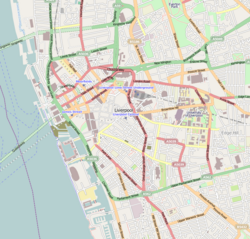Liverpool Metropolitan Cathedral
| Liverpool Metropolitan Cathedral | |
|---|---|
| Metropolitan Cathedral of Christ the King | |

Liverpool Metropolitan Cathedral, Mount Pleasant
|
|
| Coordinates: 53°24′17″N 2°58′08″W / 53.4047°N 2.9688°W | |
| Location | Liverpool, Merseyside |
| Country | England |
| Denomination | Roman Catholic |
| Website | liverpoolmetrocathedral.org.uk |
| Architecture | |
| Architect(s) |
Sir Edwin Lutyens Sir Frederick Gibberd |
| Specifications | |
| Height | 84.86m |
| Diameter | 59.43m |
| Administration | |
| Archdiocese | Liverpool |
| Province | Liverpool |
| Clergy | |
| Bishop(s) |
Archbishop Malcolm Patrick McMahon OP Bishop Thomas Anthony Williams |
| Dean | Anthony O'Brien |
| Laity | |
| Director of music | Christopher McElroy |
| Organist(s) | James Luxton (Assistant Director of Music) Matthew Searles (Sub-Organist) |
| Images | |
|---|---|
|
|
|
|
|
|
| Video | |
|
|
|
|
|
Liverpool Metropolitan Cathedral, officially known as the Metropolitan Cathedral of Christ the King, is the seat of the Archbishop of Liverpool and the mother church of the Roman Catholic Archdiocese of Liverpool in Liverpool, England. The Grade II* Metropolitan Cathedral is one of Liverpool's many listed buildings. To distinguish it from the Anglican Liverpool Cathedral, locals call it the "Catholic Cathedral." Nicknames for the building include "Paddy's Wigwam", "The Pope's Launching Pad", and "The Mersey Funnel".
The cathedral's architect, Frederick Gibberd, was the winner of a worldwide design competition. Construction began in 1962 and was completed in 1967. Earlier designs for a cathedral were proposed in 1853, 1933, and 1953, but none were completed.
During the Great Irish Famine (1845–1852) the Catholic population of Liverpool increased dramatically. About half a million Irish, who were predominantly Catholic, fled to England to escape the famine; many embarked from Liverpool to travel to North America while others remained in the city. Because of the increase in the Catholic population, the co-adjutor Bishop of Liverpool, Alexander Goss (1814–1872), saw the need for a cathedral. The location he chose was the grounds of St. Edward's College on St. Domingo Road, Everton.
...
Wikipedia

